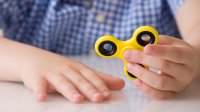Choosing the Right Fidgets for Students With Sensory Needs
By following some simple guidelines, teachers can make sure that fidgets remain valuable tools and don’t become distractions.
Your content has been saved!
Go to My Saved Content.In recent years, educators have seen many fads for fidgets, from the fidget cubes to the spinner and everything in between. For some teachers, these can be valuable classroom tools, and for others, a frustrating distraction.
When working with students with sensory needs and difficulties focusing, fidgets can be a vital tool to help them stay engaged. Students with these needs can use these tools to burn off excess energy, reduce classroom anxiety, and energize their bodies to remain involved with the lesson.
The key is to pick the right kind of fidget. They need to be quiet and low-tech and serve a purpose. The students also need to be taught the appropriate way to use them. The students must know that these are tools, not toys.
3 Characteristics of Good Fidgets
1. They’re quiet and unobtrusive. When we look for fidgets for our students to use, we need to think about how much noise they make. Generally, the quieter the better. This quietness isn’t only about the noise they make but also about how brightly colored they are. When choosing a fidget, you want to ensure that it’s not making noise that any nearby students will find distracting. Think of that person in a meeting constantly tapping or clicking their pen with nervous energy (it’s usually me). That constant noise can become incredibly distracting for others.
Typically, if a fidget is made of rubber or soft plastic, it will make less noise and be less of a distraction. On top of the noise, you also need to consider how bright the fidgets are. Most marketers create bright and shiny fidgets to attract a buyer’s eye in the store. That same phenomenon will happen in your classroom if you bring in bright and flashy fidgets for your students. This brightness turns them from a focusing tool into a toy.
2. They’re low-tech. Think as low-tech as possible when looking for fidgets for your students. The simpler the fidget, the less likely it will turn into a toy. For a couple of my students who kept losing their fidgets this year, I improvised and gave them a small piece of yarn. They used the yarn just like any other fidget, and it was simple and got the job done.
Fidgets don’t need to be expensive or cutting-edge. Most of the time, they’re just something students keep in their hands to help alleviate nervous energy.
3. They serve a definite purpose. I see the behaviors that occur in the classroom but don’t always know what tools students need to counter them. I find myself constantly asking our occupational therapists (OTs) for advice. I’ve learned that when choosing a fidget for a student, it must be purposeful. We don’t want to give Jonny a fidget spinner because it will make him happy and quiet. We want to give him a fidget spinner because it will help him focus on the lesson. We want to choose the right tool for the right job.
First, it’s essential to ask, “Why is this behavior happening? Is it work avoidance, attention seeking, or a sensory need?” When you can tell that it’s a sensory need, we can ask, “Is the student trying to get rid of excess energy, or are they having difficulty managing the sensory input of the room?” Talk with your gen-ed teachers and OT to figure this out for your student. Once you’ve done this, you can choose a starting fidget.
I work with the OTs in my building to choose the correct fidget instead of having parents send in something. Many fidgets that come from home tend to be viewed as toys. Plus, getting them from the school helps keep students in the mindset that “I’m going to use this to help me complete my work and stay on task.”
Transitioning Away From Fidgets
When you have found the right fidget, you have to start teaching the student how to use it and ensure that they understand it’s not a toy or a prize. Once they know how to use it, you have to monitor the situation to see if it works. As time passes, the student may not need to use fidgets as much. We want them to realize that they may only need these tools at certain times, such as during a longer lesson or while reading on their own.
We don’t want students to become overly dependent on fidgets but to recognize when they are becoming distracted or anxious and to use the right tool for the right job. This isn’t an exact science and will need to change as the student’s needs change. The important part is for them to know that fidgets are tools, how to use them, and how to self-advocate for their needs.
